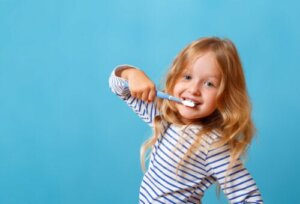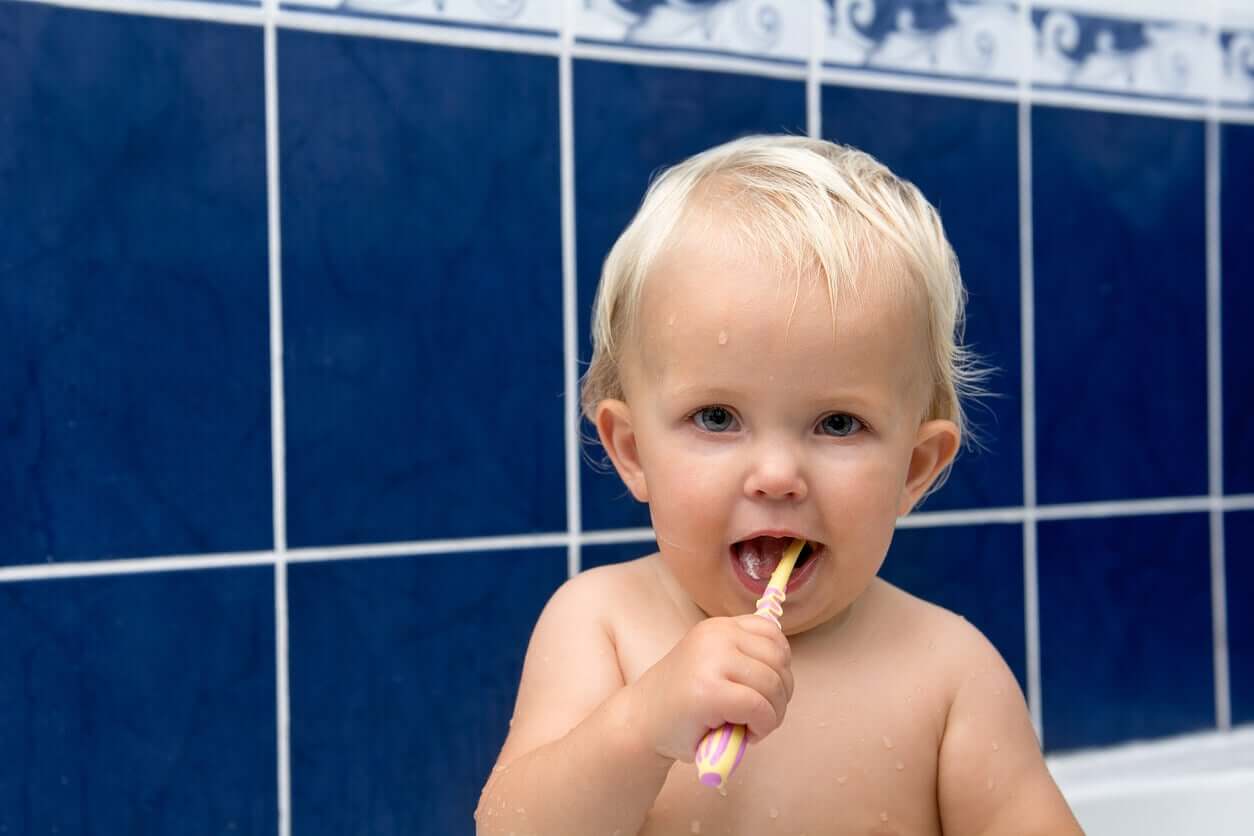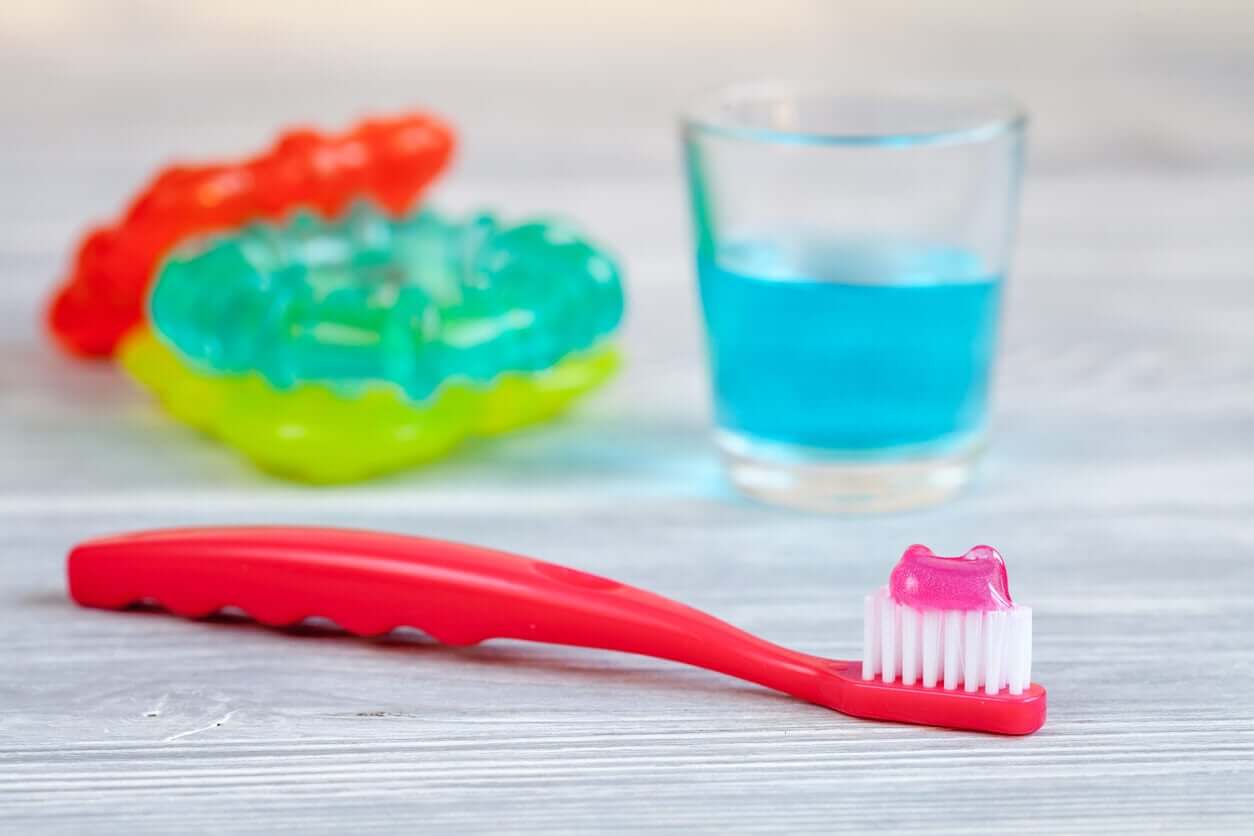6 Myths About Brushing Your Teeth

Paying attention to dental hygiene from childhood is essential in order to reach adulthood with a healthy mouth. But there are several myths about brushing your teeth that can confuse parents when it comes to taking care of their little ones.
Misinformation is a limiting and detrimental factor for health. On the contrary, being clear about what to do and what not to do helps us make better decisions and to make them consciously.
In this article, we’ll tell you 6 myths about brushing your teeth that you should in order to better care of your children’s mouths. Keep reading!
Myth 1: Brushing baby teeth isn’t important
Many parents believe that because baby teeth are transitory, they’re not worth caring for. However, the truth is that these dental elements play a very important role in the development and health of the child.
On the one hand, temporary teeth serve so that the mouth can fulfill its functions without problems: Chewing, eating, and speaking. On the other hand, their presence in the mouth helps to save the necessary space for the definitive teeth and helps to guide their correct eruption.
So, if baby teeth become diseased or lost prematurely, future malocclusions can occur.
Finally, these pieces fulfill a very important social role, as the aspect of the smile helps children interact with others without complexes or shame. For this reason, their care must begin even before the teeth appear in the mouth with correct hygiene of the gums after feeding.
After the first dental element has come out, it’s time to start brushing. A child-friendly brush with soft bristles and a toothpaste with an age-appropriate dose of fluoride should be used.
Adults are responsible for cleaning the teeth until the child can do it themselves, which occurs between 6 and 8 years. Then, parents must accompany and supervise so that the hygiene technique is correct.
Check-ups with a pediatric dentist from the first year of the child’s life help to keep the mouth healthy. During these controls, the professional reviews the state of the little one’s dental health and advises the parents about the correct care of their mouth at home.

Myth 2: Brushing your teeth once a day is enough
This is another of the myths that can bring problems in the state of a child’s oral health, as it’s best to brush your teeth at least 2 times a day: when you get up and before going to bed at night.
With 2 or 3 daily brushings, the bacterial plaque that’s deposited on the dental surfaces is dispersed. Therefore, their accumulation and the production of the acids responsible for cavities are avoided.
Also, tooth brushing should take about 2 minutes. Parents may find it helpful to sing the happy birthday song while brushing or opt for brushes with timers.
Myth 3: Children shouldn’t use toothpaste
The belief that it’s not necessary for children to use toothpaste is another one of the myths about tooth brushing that’s heard frequently.
The truth is, for several years, experts recommended not using fluoridated toothpastes in children under 2 years of age. But at present, the general recommendation is to start using a fluoride toothpaste as soon as brushing begins. Of course, you need to pay attention to the concentrations of this element in the product and use only the necessary amount.
Too much toothpaste can lead to fluorosis problems, which is why adults should dispense toothpaste in the appropriate amounts for each age.
According to the American Dental Association (ADA), you should use toothpaste according to the following recommendations:
- In children from 0 to 3 years old, a small dollop of the product should be placed on the brush, smaller than a grain of rice.
- In infants from 3 to 6 years old, the amount of paste to use is the size of a pea. At this age, children should be encouraged to spit out all of the product after brushing.
- In people over 6 years of age, the dose of paste to use is approximately 1 centimeter.
These are the generally suggested doses, which may vary slightly depending on the case. In any case, it’s best for the pediatric dentist to advise each family on this and other aspects of hygiene, depending on the child’s risk of tooth decay.
Myth 4: If mouthwash is used, brushing your teeth isn’t necessary
The bristles of the brush are the only thing capable of sweeping and dispersing bacterial plaque, which is why toothbrushes are essential when it comes to oral hygiene.
The use of dental mouthwashes can provide some extra benefits, such as the reduction of microorganisms or the added contribution of fluoride to prevent cavities.
The use of the toothbrush should never be replaced by mouthwash and in fact, the need for these products is at the discretion of the pediatric dentist.

Myth 5: Brushing your teeth cleans all tooth surfaces
It’s true that a good tooth brushing must reach all the sides of all the teeth in the mouth. Therefore, the bristles clean the inner, outer, and occlusal surfaces. But the interdental faces can’t be reached by the brush. So, to be able to sanitize them properly, you must resort to the use of dental floss or special brushes designed for this purpose.
With dental floss, the hygiene of the teeth is completed and the bacterial plaque and the remains of food that accumulate are eliminated.
Myth 6: You have to brush your teeth vigorously
There’s a belief that the more energetic the cleansing movements, the better the results. But this isn’t so.
A quick, forceful, and rough brushing not only fails to eliminate bacteria correctly but also wears the tooth surfaces and traumatizes the gums.
Controlled, precise, and smooth movements are less damaging and much more effective. Brushing must be conscious in order to properly clean each corner of the mouth without damaging its structures.
The help of a pediatric dentist
Taking care of oral health is a task that begins from childhood. Helping your little ones in your home incorporate healthy habits from an early age is the responsibility of the adults who take care of them.
For this reason, it’s essential that you be careful with the information that comes from the internet or from family and friends. Nowadays, it’s common to find home remedies or myths about the care of the mouth that, as you’ve seen, can be harmful.
The key to providing good oral health to little ones is to visit the pediatric dentist frequently. With visits to the dentist, responsibility, and proper information, children’s smiles will be in good hands.
Paying attention to dental hygiene from childhood is essential in order to reach adulthood with a healthy mouth. But there are several myths about brushing your teeth that can confuse parents when it comes to taking care of their little ones.
Misinformation is a limiting and detrimental factor for health. On the contrary, being clear about what to do and what not to do helps us make better decisions and to make them consciously.
In this article, we’ll tell you 6 myths about brushing your teeth that you should in order to better care of your children’s mouths. Keep reading!
Myth 1: Brushing baby teeth isn’t important
Many parents believe that because baby teeth are transitory, they’re not worth caring for. However, the truth is that these dental elements play a very important role in the development and health of the child.
On the one hand, temporary teeth serve so that the mouth can fulfill its functions without problems: Chewing, eating, and speaking. On the other hand, their presence in the mouth helps to save the necessary space for the definitive teeth and helps to guide their correct eruption.
So, if baby teeth become diseased or lost prematurely, future malocclusions can occur.
Finally, these pieces fulfill a very important social role, as the aspect of the smile helps children interact with others without complexes or shame. For this reason, their care must begin even before the teeth appear in the mouth with correct hygiene of the gums after feeding.
After the first dental element has come out, it’s time to start brushing. A child-friendly brush with soft bristles and a toothpaste with an age-appropriate dose of fluoride should be used.
Adults are responsible for cleaning the teeth until the child can do it themselves, which occurs between 6 and 8 years. Then, parents must accompany and supervise so that the hygiene technique is correct.
Check-ups with a pediatric dentist from the first year of the child’s life help to keep the mouth healthy. During these controls, the professional reviews the state of the little one’s dental health and advises the parents about the correct care of their mouth at home.

Myth 2: Brushing your teeth once a day is enough
This is another of the myths that can bring problems in the state of a child’s oral health, as it’s best to brush your teeth at least 2 times a day: when you get up and before going to bed at night.
With 2 or 3 daily brushings, the bacterial plaque that’s deposited on the dental surfaces is dispersed. Therefore, their accumulation and the production of the acids responsible for cavities are avoided.
Also, tooth brushing should take about 2 minutes. Parents may find it helpful to sing the happy birthday song while brushing or opt for brushes with timers.
Myth 3: Children shouldn’t use toothpaste
The belief that it’s not necessary for children to use toothpaste is another one of the myths about tooth brushing that’s heard frequently.
The truth is, for several years, experts recommended not using fluoridated toothpastes in children under 2 years of age. But at present, the general recommendation is to start using a fluoride toothpaste as soon as brushing begins. Of course, you need to pay attention to the concentrations of this element in the product and use only the necessary amount.
Too much toothpaste can lead to fluorosis problems, which is why adults should dispense toothpaste in the appropriate amounts for each age.
According to the American Dental Association (ADA), you should use toothpaste according to the following recommendations:
- In children from 0 to 3 years old, a small dollop of the product should be placed on the brush, smaller than a grain of rice.
- In infants from 3 to 6 years old, the amount of paste to use is the size of a pea. At this age, children should be encouraged to spit out all of the product after brushing.
- In people over 6 years of age, the dose of paste to use is approximately 1 centimeter.
These are the generally suggested doses, which may vary slightly depending on the case. In any case, it’s best for the pediatric dentist to advise each family on this and other aspects of hygiene, depending on the child’s risk of tooth decay.
Myth 4: If mouthwash is used, brushing your teeth isn’t necessary
The bristles of the brush are the only thing capable of sweeping and dispersing bacterial plaque, which is why toothbrushes are essential when it comes to oral hygiene.
The use of dental mouthwashes can provide some extra benefits, such as the reduction of microorganisms or the added contribution of fluoride to prevent cavities.
The use of the toothbrush should never be replaced by mouthwash and in fact, the need for these products is at the discretion of the pediatric dentist.

Myth 5: Brushing your teeth cleans all tooth surfaces
It’s true that a good tooth brushing must reach all the sides of all the teeth in the mouth. Therefore, the bristles clean the inner, outer, and occlusal surfaces. But the interdental faces can’t be reached by the brush. So, to be able to sanitize them properly, you must resort to the use of dental floss or special brushes designed for this purpose.
With dental floss, the hygiene of the teeth is completed and the bacterial plaque and the remains of food that accumulate are eliminated.
Myth 6: You have to brush your teeth vigorously
There’s a belief that the more energetic the cleansing movements, the better the results. But this isn’t so.
A quick, forceful, and rough brushing not only fails to eliminate bacteria correctly but also wears the tooth surfaces and traumatizes the gums.
Controlled, precise, and smooth movements are less damaging and much more effective. Brushing must be conscious in order to properly clean each corner of the mouth without damaging its structures.
The help of a pediatric dentist
Taking care of oral health is a task that begins from childhood. Helping your little ones in your home incorporate healthy habits from an early age is the responsibility of the adults who take care of them.
For this reason, it’s essential that you be careful with the information that comes from the internet or from family and friends. Nowadays, it’s common to find home remedies or myths about the care of the mouth that, as you’ve seen, can be harmful.
The key to providing good oral health to little ones is to visit the pediatric dentist frequently. With visits to the dentist, responsibility, and proper information, children’s smiles will be in good hands.
All cited sources were thoroughly reviewed by our team to ensure their quality, reliability, currency, and validity. The bibliography of this article was considered reliable and of academic or scientific accuracy.
- Holmgren, C., & Benzian, H. (2018). Global recommendations to prevent tooth decay must be evidence-based. Eastern Mediterranean Health Journal, 24(10), 973.
- Thornton-Evans, G., Junger, M. L., Lin, M., Wei, L., Espinoza, L., & Beltran-Aguilar, E. (2019). Use of toothpaste and toothbrushing patterns among children and adolescents—United States, 2013–2016. Morbidity and Mortality Weekly Report, 68(4), 87.
- Walsh, T., Worthington, H. V., Glenny, A. M., Appelbe, P., Marinho, V. C., & Shi, X. (2010). Fluoride toothpastes of different concentrations for preventing dental caries in children and adolescents. Cochrane database of systematic reviews, (1).
- Arrieta-Vergara, K. M., González-Martínez, F., & Luna-Ricardo, L. (2011). Exploración del riesgo para fluorosis dental en niños de las clínicas odontológicas universidad de Cartagena. Revista de salud pública, 13, 672-683.
- Acosta-Andrade, A., David-Solórzano, J., Pico-Sornoza, A., Sinchiguano-Quinto, K., & Zambrano-Torres, J. (2021). Correcto cepillado dental en niños: Artículo de revisión bibliográfica. Revista Científica Arbitrada en Investigaciones de la Salud GESTAR. ISSN: 2737-6273., 4(7), 2-22.
- Soria-Hernández, M. A., Molina, N., & Rodríguez, R. (2008). Hábitos de higiene bucal y su influencia sobre la frecuencia de caries dental. Acta pediátrica de México, 29(1), 21-24.
- Pita-Fernández, S., Pombo-Sánchez, A., Suárez-Quintanilla, J., Novio-Mallón, S., Rivas-Mundiña, B., & Pértega-Díaz, S. (2010). Relevancia clínica del cepillado dental y su relación con la caries. Atención primaria, 42(7), 372-379.
- Solis, G., Pesaressi, E., & Mormontoy, W. (2020). Tendencia y factores asociados a la frecuencia de cepillado dental en menores de doce años, Perú 2013-2018. Revista Peruana de Medicina Experimental y Salud Pública, 36, 562-572.
This text is provided for informational purposes only and does not replace consultation with a professional. If in doubt, consult your specialist.








